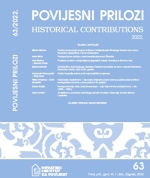The Noble Manor of Vukovar: Slavonia and Syrmia in the First Half of the 18th Century According to Censuses and Maps
DOI:
https://doi.org/10.22586/pp.v41i63.21701Keywords:
Slavonija, vukovarsko vlastelinstvo, komorski popis, atlas vukovarskog vlastelinstva, 18. stoljeće, gospodarstvoAbstract
Based on the chamber census of 1728 and Frast’s maps of the noble manor of Vukovar from 1733, the authors have reached conclusions on the socio-economic situation of the newly created Vukovar estate using quantitative methods. The analysis of the Chamber census from 1728 shows the state of economy on the future manor (farming, livestock breeding, and viticulture). Significant differences have been observed in the economic development of different settlement categories (city, marketplace, village). At the current level of research, it has not been possible to conclude whether these differences were caused by the urbanization of Vukovar, which became the seat of the noble manor, and later also of the newly created Syrmian County, or by some other process. The Chamber census allows us to determine the amount of tax burden, as well as the manorial income on the basis of which the Palace Chamber determined the value of the future manor and the amount that the new owner had to pay into the treasury of the Palace Chamber for the ownership right of the female line of the Küffstein family.
Downloads
Published
How to Cite
Issue
Section
License
Copyright (c) 2022 Authors and journal

This work is licensed under a Creative Commons Attribution-NonCommercial 4.0 International License.







